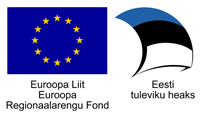Project funding
Project is supported by:
European Regional Development Fund
Budget: 823 500,04 EUR
Contribution: 699 975,02 EUR
Self-financing by Tallinn University, Haapsalu Neurological Rehabilitation Centre and Haapsalu Municipality
Contact
Director
Eva Makienko
Phone: +372 472 0356
eva.makienko@tlu.ee
Project Manager
Talis Vare
Phone: +372 472 0350
talis.vare@hk.tlu.ee
Period 2016-2019
As a result of the applied research and development in the project period of 2016-2019 new competences will be formed that support the achievement of the measure’s main goal of improving the business environment, including the creation of new jobs with higher added value.
Existing enterprises are supported by the Centre’s knowledge and infrastructure in developing new products and services. Also the Centre supports the formation of new enterprises in Lääne County and in the whole of Estonia.
The Centre helps to promote and increase research and development in the field mobility and operational capacity, and to train and employ top specialists in the field. The Centre will develop into the region’s hub of innovation and the administrator and mediator of the sector’s know-how. Through the Centre’s laboratories, the lecturers and students of the different study programmes of Haapsalu College (Handicraft Technology and Design, Health Promotion Specialist, Applied Computer Science) are involved in the Centre’s work.
Goals and excpected results
The results of the project create the conditions for the growth of GDP in the Centre’s field as well as related economic sectors. To achieve this, the following specific goals have been set:
- Determining the composition and quality of the mud resources in deposits, which forms the basis of product and service development; creating a quality assurance system of muds. This enables us to develop innovative uses for the currently underused resource.
- Finding innovative approaches in product and environment solutions as well as intervention methods to achieve greater efficiency in preventing cases of injury and death by injury.
- Developing new interventions, methodologies and conceptual solutions for the treatment and management environments of people with spinal cord and brain damage.
- Completing the studies and developments started in the 2012-15 period, to enable their use by the field’s enterprises.


